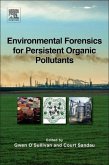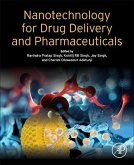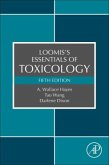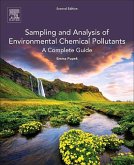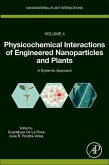Persistent Organic Pollutants (POPs): Analytical Techniques, Environmental Fate and Biological Effects
Herausgegeben:Zeng, Eddy Y
Persistent Organic Pollutants (POPs): Analytical Techniques, Environmental Fate and Biological Effects
Herausgegeben:Zeng, Eddy Y
- Gebundenes Buch
- Merkliste
- Auf die Merkliste
- Bewerten Bewerten
- Teilen
- Produkt teilen
- Produkterinnerung
- Produkterinnerung
This book focuses on those organic chemicals that are regulated by the Stockholm Convention on Persistent Organic Pollutants (POPs). as well as organic chemical with the attributes of being persistent, bioaccumulative, and toxic to ecosystem and human beings, criteria used by the Stockholm Convention for screening POP candidates. Because of the unfavourable properties of POPs, numerous research efforts have been directed toward investigating their input sources, fate, and effects, with the help of continuously improving analytical technologies. The contributors to this book provide an…mehr
Andere Kunden interessierten sich auch für
![Environmental Forensics for Persistent Organic Pollutants Environmental Forensics for Persistent Organic Pollutants]() Environmental Forensics for Persistent Organic Pollutants121,99 €
Environmental Forensics for Persistent Organic Pollutants121,99 €![Health and Environmental Safety of Nanomaterials Health and Environmental Safety of Nanomaterials]() Health and Environmental Safety of Nanomaterials161,99 €
Health and Environmental Safety of Nanomaterials161,99 €![Nanotechnology for Drug Delivery and Pharmaceuticals Nanotechnology for Drug Delivery and Pharmaceuticals]() Nanotechnology for Drug Delivery and Pharmaceuticals113,99 €
Nanotechnology for Drug Delivery and Pharmaceuticals113,99 €![Loomis's Essentials of Toxicology Loomis's Essentials of Toxicology]() A. Wallace HayesLoomis's Essentials of Toxicology65,99 €
A. Wallace HayesLoomis's Essentials of Toxicology65,99 €![Fluorine in Life Sciences: Pharmaceuticals, Medicinal Diagnostics, and Agrochemicals Fluorine in Life Sciences: Pharmaceuticals, Medicinal Diagnostics, and Agrochemicals]() Fluorine in Life Sciences: Pharmaceuticals, Medicinal Diagnostics, and Agrochemicals161,99 €
Fluorine in Life Sciences: Pharmaceuticals, Medicinal Diagnostics, and Agrochemicals161,99 €![Sampling and Analysis of Environmental Chemical Pollutants Sampling and Analysis of Environmental Chemical Pollutants]() E. P. PopekSampling and Analysis of Environmental Chemical Pollutants112,99 €
E. P. PopekSampling and Analysis of Environmental Chemical Pollutants112,99 €![Physicochemical Interactions of Engineered Nanoparticles and Plants Physicochemical Interactions of Engineered Nanoparticles and Plants]() Physicochemical Interactions of Engineered Nanoparticles and Plants128,99 €
Physicochemical Interactions of Engineered Nanoparticles and Plants128,99 €-
-
-
This book focuses on those organic chemicals that are regulated by the Stockholm Convention on Persistent Organic Pollutants (POPs). as well as organic chemical with the attributes of being persistent, bioaccumulative, and toxic to ecosystem and human beings, criteria used by the Stockholm Convention for screening POP candidates. Because of the unfavourable properties of POPs, numerous research efforts have been directed toward investigating their input sources, fate, and effects, with the help of continuously improving analytical technologies. The contributors to this book provide an integrated assessment of existing data, which will benefit both the scientific and management communities in planning further research projects and/or pollution control measures.
Produktdetails
- Produktdetails
- Comprehensive Analytical Chemistry Volume 67
- Verlag: Elsevier / Elsevier Science & Technology
- Artikelnr. des Verlages: C2012-0-07029-9
- Englisch
- Abmessung: 34mm x 152mm x 229mm
- Gewicht: 1130g
- ISBN-13: 9780444632999
- Artikelnr.: 41826492
- Comprehensive Analytical Chemistry Volume 67
- Verlag: Elsevier / Elsevier Science & Technology
- Artikelnr. des Verlages: C2012-0-07029-9
- Englisch
- Abmessung: 34mm x 152mm x 229mm
- Gewicht: 1130g
- ISBN-13: 9780444632999
- Artikelnr.: 41826492
Dr. Eddy Y. Zeng is a Full Professor and Dean of the School of Environment, Jinan University, China. He received his Ph.D. degree from the University of Southern California in 1992. He was employed by the Southern California Coastal Water Research Project first as Senior Scientist and then Principal Scientist for a number of years, before returning to China in 2004. His research interests include 1) intercompartmental processes and fluxes of persistent organic pollutants (POPs); 2) human exposure to persistent toxic substances and risk assessment; 3) occurrence and toxic effects of microplastics/plastics in terrestrial and aquatic environments; and 4) the utility of using passive sampler to measure freely dissolved concentrations of POPs in the aquatic environment. He is currently the Editor-in-Chief of Environmental Pollution and Associate Editor of Environmental Toxicology and Chemistry. He also served as guest editors on numerous journals.
1. Analytical methods for the measurement of legacy and emerging POPs in complex sample matricesYing Guo and Kurunthachalam Kannan2. Bioanalytical approaches to understanding toxicological implications of mixtures of persistent organic pollutants in marine wildlifeLing Jin, Caroline Gaus, and Beate I. Escher3. Fast analytical techniques based on microextractionRuifen Jiang and Gangfeng Ouyang4. Application of passive sampling techniques in measurement of HOCs in aquatic environmentsLian-Jun Bao and Eddy Y. Zeng 5. Assessment of sediment toxicity with SPME-based approachesJing You, Huizhen Li, and Michael J. Lydy6. Pharmaceuticals and personal care products (PPCPs) in the environment and their removal from wastewater through constructed wetlandsCristina Ávila and Joan García 7. Occurrence and fate of PPCPs in wastewaterTrine Eggen and Christian Vogelsang8. Atmospheric deposition of POPs: Implications for the chemical pollution of aquatic environmentsJavier Castro Jiménez, Jordi Dachs and Steven J. Eisenreich9. Electronic waste: a new source of halogenated organic contaminantsHong-Gang Ni and Eddy Y. Zeng10. Occurrence and human health risk of emerging organic contaminants in E-wasteDavid O. Carpenter11. Long-range and regional atmospheric transport of POPs and implications for global cyclingKimberly J. Hageman, Christian Bogdal, and Martin Scheringer12. Occurrence and ecological risk of halogenated flame retardants (HFRs) in coastal zonesJames C.W. Lam and Paul K.S. Lam13. Atmospheric long-range transport of persistent organic pollutants (POPs) into Polar RegionsRoland Kallenborn, Hayley Hung, and Eva Brorstrøm-Lundén 14. Bioaccumulation and biotransformation of brominated flame retardantsLiesbeth Weijs, Alin C. Dirtu, Govindan Malarvannan, and Adrian Covaci15. Bioavailability of persistent organic pollutants in soils: concept, analytical tools and application in the risk assessment, Bilqees M. Adedigba and Kirk, T. Semple16. Benzotriazoles: history, environmental distribution and potential ecological effectsMark G. Cantwell, Julia C. Sullivan, and Robert M. Burgess17. QSARs on the thyroid hormone effects of polybrominated diphenyl ether (PBDE) derivativesFei Li, Xianhai Yang, Jingwen Chen, and Felichesmi Lyakurwa18. The toxicity of persistent organic pollutants to aquatic organismsS. Michele Harmon19. Health-based risk assessment of PBDEs, Li Chen, Lucy Li, and Yunhui Zhang
1. Analytical methods for the measurement of legacy and emerging POPs in complex sample matricesYing Guo and Kurunthachalam Kannan2. Bioanalytical approaches to understanding toxicological implications of mixtures of persistent organic pollutants in marine wildlifeLing Jin, Caroline Gaus, and Beate I. Escher3. Fast analytical techniques based on microextractionRuifen Jiang and Gangfeng Ouyang4. Application of passive sampling techniques in measurement of HOCs in aquatic environmentsLian-Jun Bao and Eddy Y. Zeng 5. Assessment of sediment toxicity with SPME-based approachesJing You, Huizhen Li, and Michael J. Lydy6. Pharmaceuticals and personal care products (PPCPs) in the environment and their removal from wastewater through constructed wetlandsCristina Ávila and Joan García 7. Occurrence and fate of PPCPs in wastewaterTrine Eggen and Christian Vogelsang8. Atmospheric deposition of POPs: Implications for the chemical pollution of aquatic environmentsJavier Castro Jiménez, Jordi Dachs and Steven J. Eisenreich9. Electronic waste: a new source of halogenated organic contaminantsHong-Gang Ni and Eddy Y. Zeng10. Occurrence and human health risk of emerging organic contaminants in E-wasteDavid O. Carpenter11. Long-range and regional atmospheric transport of POPs and implications for global cyclingKimberly J. Hageman, Christian Bogdal, and Martin Scheringer12. Occurrence and ecological risk of halogenated flame retardants (HFRs) in coastal zonesJames C.W. Lam and Paul K.S. Lam13. Atmospheric long-range transport of persistent organic pollutants (POPs) into Polar RegionsRoland Kallenborn, Hayley Hung, and Eva Brorstrøm-Lundén 14. Bioaccumulation and biotransformation of brominated flame retardantsLiesbeth Weijs, Alin C. Dirtu, Govindan Malarvannan, and Adrian Covaci15. Bioavailability of persistent organic pollutants in soils: concept, analytical tools and application in the risk assessment, Bilqees M. Adedigba and Kirk, T. Semple16. Benzotriazoles: history, environmental distribution and potential ecological effectsMark G. Cantwell, Julia C. Sullivan, and Robert M. Burgess17. QSARs on the thyroid hormone effects of polybrominated diphenyl ether (PBDE) derivativesFei Li, Xianhai Yang, Jingwen Chen, and Felichesmi Lyakurwa18. The toxicity of persistent organic pollutants to aquatic organismsS. Michele Harmon19. Health-based risk assessment of PBDEs, Li Chen, Lucy Li, and Yunhui Zhang


